Aloe vera is easy to grow succulent that produces an extremely beneficial gel within its leaves. This gel is produced by storing water from its growing environment and thickening within the cell walls.
The known benefits of the aloe moisturizing wonder gel include soothing sunburns, bug bites, minor cuts or wounds, and a range of other skin problems.
But, can aloe vera plants survive cold weather?
Honestly speaking, aloe vera plant can’t survive extreme cold weather. Their leaves become frozen in cold temperature, and due to that the cell walls swell up and eventually explode, and that causes them to rot and die afterwards.
Given that this plant has many perks, it must be protected during the winter months to prevent it from freezing and expanding the cell membrane to the point of explosion.
In this article, we’ll go through everything you need to know about this plant’s ability (or inability) to survive and thrive in the cold.
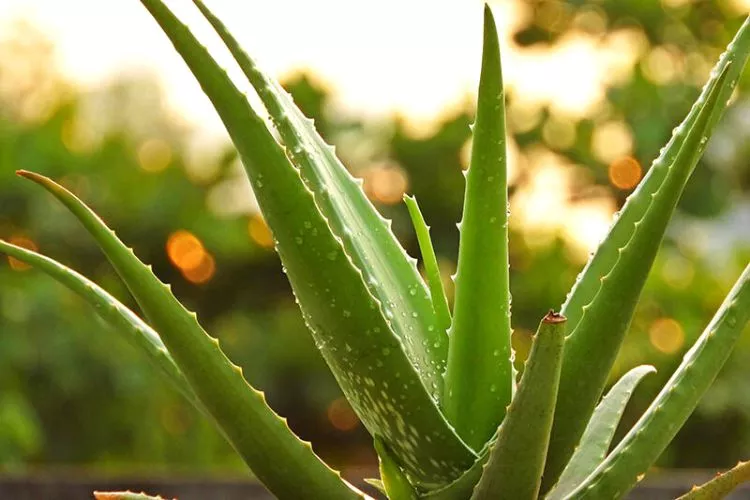
Table of Contents
Can aloe vera plants survive cold temperatures?
Most species of Aloe are frost tender and generally don’t fare too well in colder climates.
This is due to their water stores being stored within their leaves becoming so cold that they freeze. Once they become frozen, the cell walls swell up and explode, which eventually causes them to rot and die. Of course, it all depends on the area in which they are grown.
The natural habitat of an Aloe plant is considered dry. They are often found growing in these climates in areas such as the South Eastern Arabian Peninsula, parts of Africa, and India. Many common species derive from Southern African regions, where they enjoy subtropical summer and winter rainfall.
Therefore, they aren’t naturally used to cold climates. However, it is possible to offer them protection if grown outdoors and cannot be moved inside during winter.
This can include simply driving a few stakes into the ground around them and draping a blanket or adding a thick layer of mulch to keep their root system insulated.
The Aloe Vera plant will become dormant when the colder seasons start to roll in. Meaning its rate of growth will slow down as the sun is less present, and it reduces its water intake as a result. This process occurs so that the plant can conserve energy for when the warm weather begins to show again.
What temperature is too cold for an aloe vera plant?
Aloe vera plants generally thrive best when their growing environment is between 55-80°F (13-27°C). This is considered a ‘normal’ temperature for most homes, making them the perfect houseplant.
When temperatures are between 40-55°F (4.5-13°C), they will begin shutting down as they attempt to conserve energy.
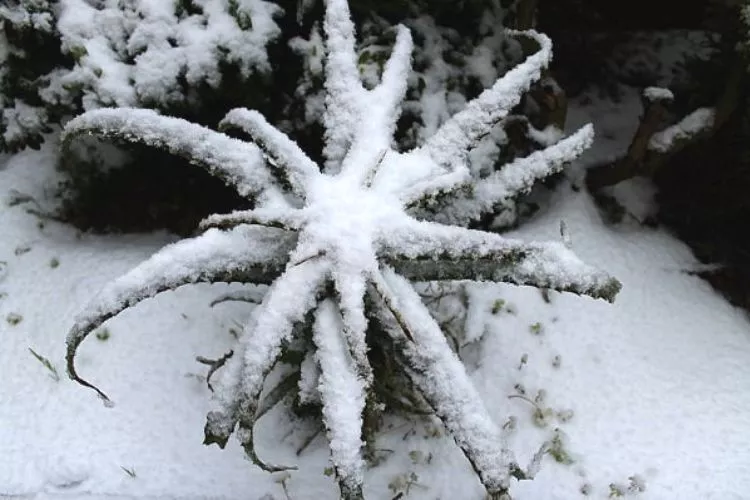
Any lower than 40°F (4.5°C) is dangerous for these fleshy plants. The moisture filled leaves will swell up and eventually freeze. This process will ensure that the leaves explode, and the plant will struggle to heal and die as a result.
Some Aloe species are more cold hardy which include Aloe arborescens (Torch Aloe), Aloe Aristata (Lace Aloe), and Aloe Broomii (Snake Aloe), to name a few.
How to care for aloe vera plants in cold climates?
If you live somewhere where colder climates can become an issue for your Aloe Vera plants, there is hope! Sometimes all it takes is a few simple tweaks to help ensure that these chill intolerant plants are nursed through the winter so they can thrive again in the warmer months.
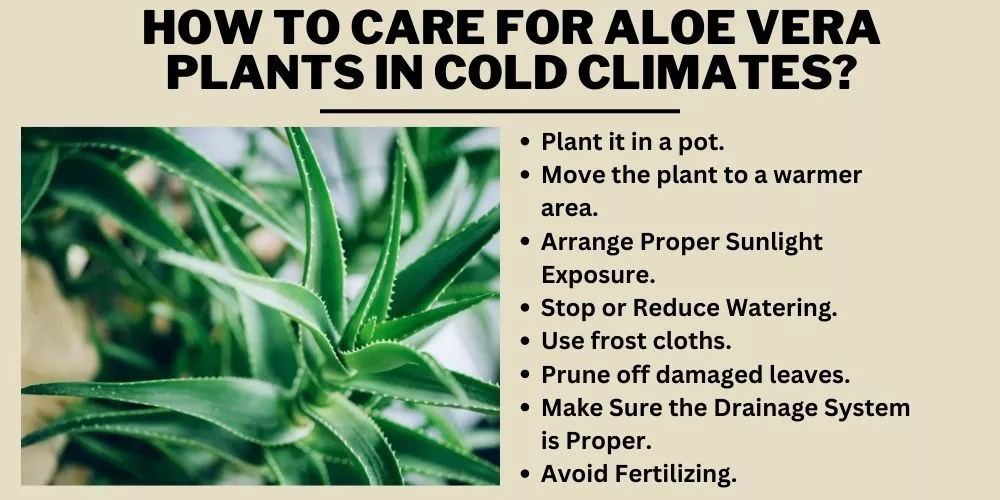
Let’s look at some really efficient ways to ensure their survival during the colder periods without doing anything too drastic.
Plant it in a pot
An Aloe plant growing in the ground during the colder months may need some kind of protection depending on any impending heavy winds, snow, rain, etc.
However, a simple hack to avoid doing anything like this is to dig them up and put them in a growing container.
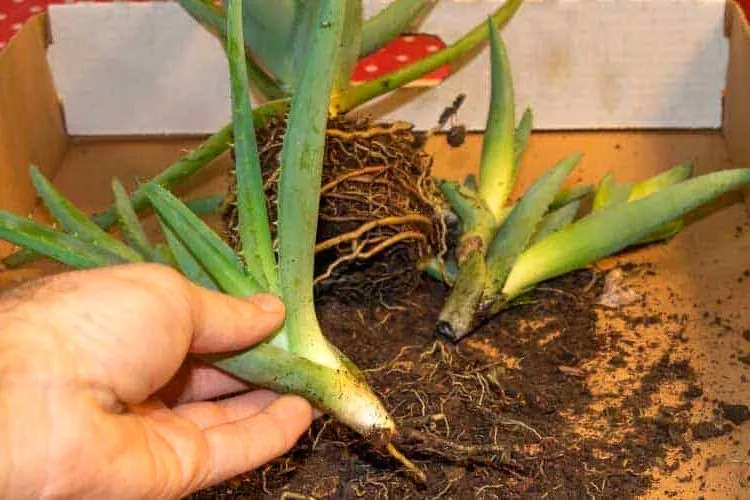
Once in a pot, they are much easier to maneuver around. You can move them indoors or undercover to give some much-needed respite. If you choose to go down this path, it’s best to pull them up and establish them in their new home early in the fall.
There will still be enough warmth during this time for the roots to strengthen,, which is essential for plant stability.
Move the plant to a warmer area
One of the easiest things you can do to protect your Aloe plant during the winter is to relocate them. If they are outside, move them under a porch, into a garage, or behind a windbreak like a wall.
Alternatively, just move them indoors so you can give them all the love they require to grow like wildfire comes spring again.
The best spots for an indoor Aloe plant include on a windowsill where they can receive plenty of sun, on top of a fridge where the motor usually keeps that area warm, or even under some grow lights.
Arrange Proper Sunlight Exposure
Sunlight is extremely important for the survival of not just Aloe plants but all plants. Plants use sunlight for photosynthesis.
This produces usable energy for the plant to stay alive. Without the sun or a source of light, all plant forms would die and never be able to reproduce.
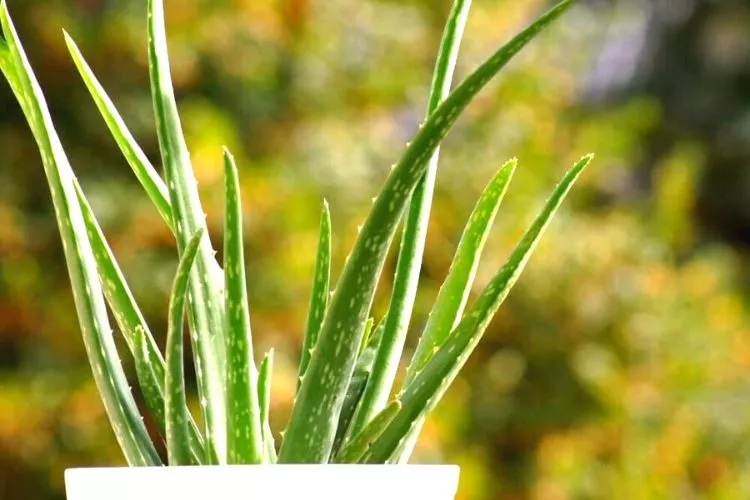
So if you have plants somewhere where the sun just can’t reach them, try moving them somewhere that receives at least 6 hours of full, indirect sunlight. Be careful moving them from complete shade to sunlight; it’s best to try to wean them a little bit to avoid shock.
Stop or Reduce Watering
Aloe Vera goes dormant during the colder months. It shuts itself down to conserve energy. Therefore, it requires minimal food or water during these times.
Aim to water them once every 3-4 weeks but always test the condition of the soil before doing so. If the soil is moist, allow it to dry out completely before even considering watering.
Any excess water will freeze and kill the plant or sit stagnant around the roots as they deny it. When the roots sit in stagnant water, they rot,, and this disease slowly spreads throughout the whole plant. The roots are where all the growth comes from, so if they become damaged, it will be a struggle for the plant able to heal itself.
Use frost cloths
Another measure you can take to protect your Aloe plants during winter is utilizing frost cloths. Also known as reemay or row covers, a frost cloth is a lightweight white colored fabric. They are generally manufactured using materials such as polypropylene or polyester.
These cloths are gently placed over plants that may not fare too well in the colder months to offer some protection from these chills. The beauty of these clothes is that they can be utilized in both the daytime and nighttime. They allow water and light to penetrate,, allowing the plants to grow when covered.
Prune off damaged leaves
When the winter starts to dry out and spring rolls in, you may notice that your Aloe plants have become damaged by frostbite. If this is the case, it’s a good idea to grab a pair of sterilized garden shears or a sharp knife and do some minor surgery.
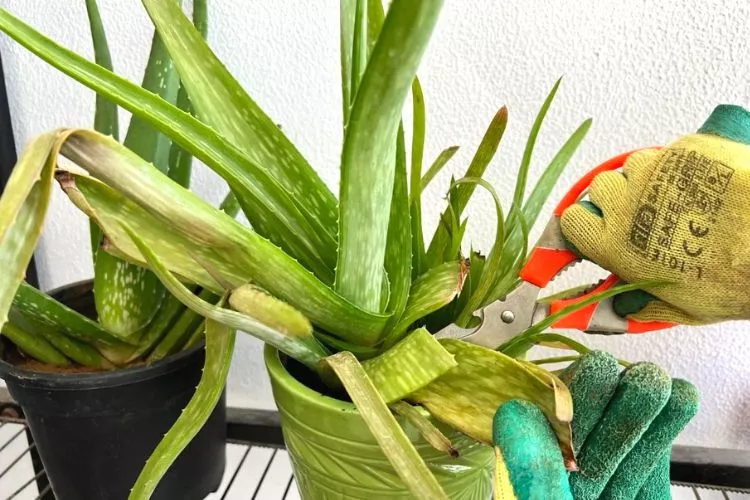
However, it’s recommended to wait until the flower cycle has been completed before doing so. This is usually around May. Start with any outside leaves and work your way inside to the point where the plant is uniform. These plants require a bit of maintenance regardless of damage, so don’t be shy to help reshape them.
Make Sure the Drainage System is Proper
Adequate drainage is crucial to the overall health of an Aloe plant. They are prone to succumbing to wilting and root rot caused by excess watering and poor drainage. It’s best not to use regular gardening soils when preparing to plant an Aloe.
Instead, a good mix should include perlite, lava rock, chunks of bark, or all three. When moisture cannot drain away in the winter, it can freeze around the plant. This essentially causes a blockage for any other water to penetrate if required. Always stick to a strict watering schedule when nurturing Aloe plants during winter.
Avoid Fertilizing
Aloe Vera plants don’t require much in the way of fertilization if any at all. Regardless of the season, Aloes get most of their nutrients via the soil. If necessary, you can give these plants some good quality cactus feed or worm castings as a once-off during the spring.
They should not be given any food in fertilizer form during the winter as they are dormant. It will only harm them.
How to Identify Cold Shock in an Aloe Vera Plant?
If your Aloe Vera plant has been slightly neglected during the colder months, it can offer some visual signs of shock to help you distinguish how to heal them. Some of the things to look out for include the following:
Dark Spots on the Leaves
Spotting of the leaves generally relates to overwatering an Aloe plant. The excess moisture stresses the plant and brings on one or multiple fungal diseases. This can be mitigated by adhering to a strict watering regime.
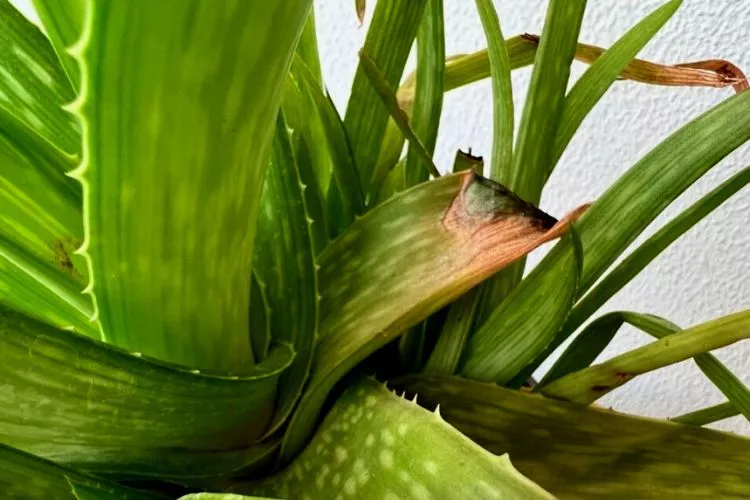
Only water when the plant’s growing media is completely dry. Even then, test the soil condition by sticking your finger around 2-3 inches into the soil. If it comes out dry, then it’s ok to apply water. If the media is still slightly moist, wait a bit longer before testing again.
Discoloration of the Leaves
Discolored leaves can be caused by several things, such as too much or too little moisture, excess salt in the soil, fungal disease, sun scorch, chemical toxicity, or nutrient deficiency. The cold shock usually presents discolored leaves when any of the mentioned causes are in view.
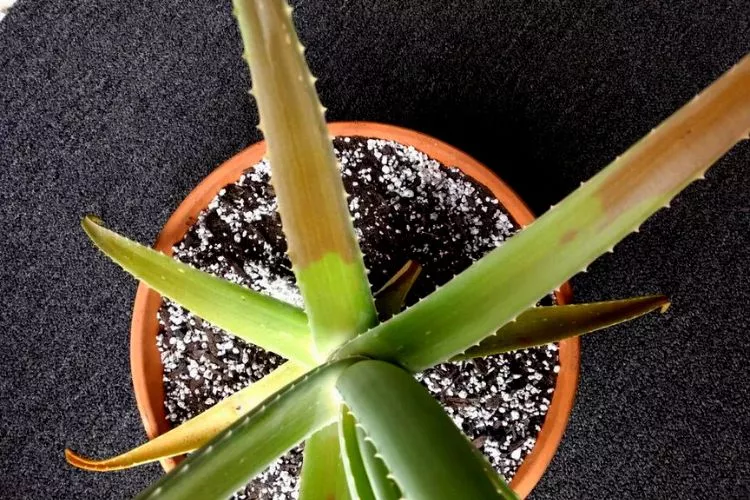
Excess moisture is common when overwatering occurs. Excess salts appear when there is only enough water to serve the plant, and the salts in the soil crystalize. The fungal disease generally comes from overwatering; chemical toxicity occurs when nutrients are administered during winter (which they shouldn’t be).
Sun scorch and nutrient deficiency are probably the only 2 that don’t contribute to leaf discoloration during winter. The leaves can fade into browns, grays, dull yellows, and even blacks in later cases.
Drooping Leaves
The leaves of your Aloe plant will droop during the colder months when insufficient sun is present. They can also become leggy as they try to reach for any light they can. The weight of the elongated leaves makes them sag.
Furthermore, cold weather, in general, can cause these types of succulents to flop as they become weakened. Lastly, excess water will make the plant struggle to utilize it, and it can also begin to droop.
Root Rot
Root rot is a serious threat to Aloe Vera plants, especially during and just after the colder months subside. This condition is generally brought on when excess water sits stagnant around the root system. The roots dangle in this water for extended periods and simply rot.
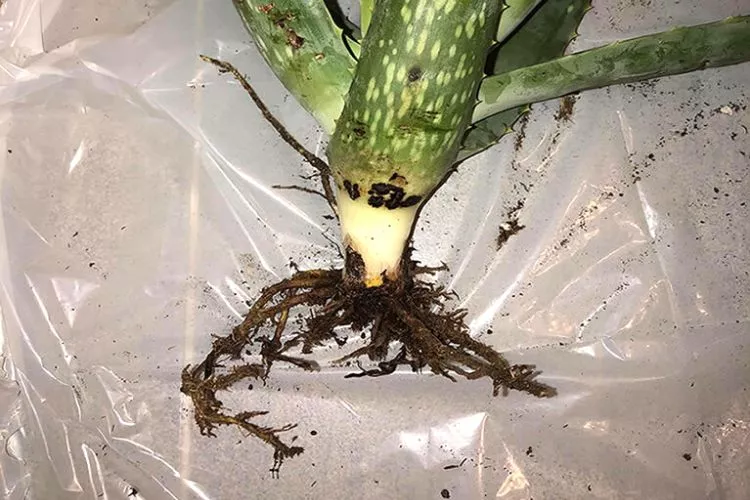
Once the roots begin to rot, the disease spreads through the plant and slowly kills it. Winters are notorious for heavier rains and even snow that can eventually melt, leaving these plants covered in the water. Once root rot takes hold of a plant, it is often difficult to correct, especially if it is not distinguished in its early stages.
Frequently Asked Questions (FAQs)
Can I keep Aloe Veras outside in the winter?
If your Aloes are growing in a winter climate that isn’t cold enough to go dormant, they can most definitely be left outside. Aloe Vera plants thrive best when grown in temperatures between 55-80°F (13-27°C).
They go dormant to conserve energy when they are subject to lowered climates that produce temperatures between 40-55°F (4.5-13°C). Anything lower than 40°F (4.5°C) can freeze them, slowly killing them.
Will the Aloe Vera Plant Come Back After a Freeze?
This will depend on the amount of frostbite that it receives. Aloe Vera can be subject to temperatures as low as 40°F (4.5°C) as long as they aren’t consistent. When these types of plants endure these temperatures for too long, their limbs will freeze, turn brown and then explode. If the roots and a smaller proportion of the lower parts of the plant stay alive and well, then it will usually be able to recover.
Conclusion:
As long as some mitigation efforts are implemented, the humble Aloe Vera plant can have a much better chance of surviving the colder months. Simple actions such as relocating them, protecting them from the elements with clothes and other shelter forms, and minimizing watering can go a long way in helping them.
Learning to read your plants’ visual signs is always a good idea to ensure that you are much better equipped to aid them during more trying times.
We hope that this guide has been helpful. You can read about similar topics here on our website. Check back again soon for more.


